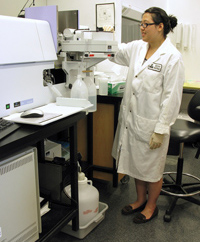Laboratories and research support: metals toxicology laboratory
| Article Title |
|---|
Metals Toxicology Laboratory |

Species are usually exposed to heavy metals after ingesting contaminated food. Negative effects include behavioural and reproductive impairment, and damage to various vital organs like the brain, liver, and kidney.
The Metals Toxicology Laboratory, located at the National Wildlife Research Centre, combines field studies and laboratory analysis to better understand and identify sources of heavy metals, explain how they are transferred through the food chain, and understand the toxic impacts heavy metals have on wildlife.
Current research and methodology
- Spent lead ammunition and the effects on water birds, upland-foraging birds of prey, and species exempt from lead-free regulations
- Secondary lead poisoning in raptors and species that forage in terrestrial habitats
- Hazards of lead shot or bullet fragments in non-retrieved game animals to the health of predators and scavengers
- Effects of ingested lead fishing tackle on loons and other aquatic species
- Tracking mercury exposure in aquatic ecosystems, and studying the accumulation and toxic effects in fish-eating birds and mammals
- Development of toxicity screening assays to assess hazards of metal and other contaminant exposure in wildlife
Research on heavy metals helps to predict adverse effects of environmental contamination on wildlife populations and aids the development of science-based environmental policies and regulations.
Some methods and equipment used to deliver on research include:
- Direct Mercury Analyzer (DMA)
- Air-Acetylene Flame Atomic Absorption Spectrophotometry (AAS)
- Graphite Furnace Atomic Absorption Spectrophotometry (GFAAS)
- Inductively Coupled Plasma Mass Spectrometry (ICP-MS)
- Stable isotope analysis
- Neuroreceptor binding and brain enzyme assays
- Liquid Beta Scintillation Spectrometry
- Radiography and portable X-ray machines
Collaboration
The Metals Toxicology Laboratory is currently participating in Environment Canada’s Clean Air Regulatory Agenda Mercury science program to identify habitats at greatest risk for mercury bioaccumulation and toxicity. Research to identify areas at risk includes investigating environmental acidification, areas affected by non-ferrous mining/smelting activities, and the high presence of mercury in underlying geology.

Through this, the Metals Toxicology Laboratory is helping to create a spatial risk assessment of current mercury levels for predatory fish and wildlife across Canada. This will help inform an ecological risk map, a key part of a comprehensive scientific plan to develop a cohesive national description of mercury pollution in Canada.
Experts
- Tony Scheuhammer
- Della Bond
Further reading
- Science Watch New Hot Paper: effects of mercury on fish and wildlife, read an interview with Tony Scheuhammer
- Historical perspective on the hazards of environmental lead from ammunition and fishing weights in Canada (PDF link)
- Mercury Must Come Down, Interdisciplinary Analyses Support Canada's Decisions on Reduction, Environment Canada
- Incidence of Lead Shot in Canada Geese, Environment Canada
- Mercury and the Environment, Environment Canada
- Canada’s Clean Air Regulatory Agenda, Treasury Board
- Clean Air Regulatory Agenda Mercury Science Program
- Collaborative Mercury Research Network (COMERN)
- Mercury research, Patuxent Wildlife Research Centre, United States Geological Survey
- Mercury, U.S. Environmental Protection Agency